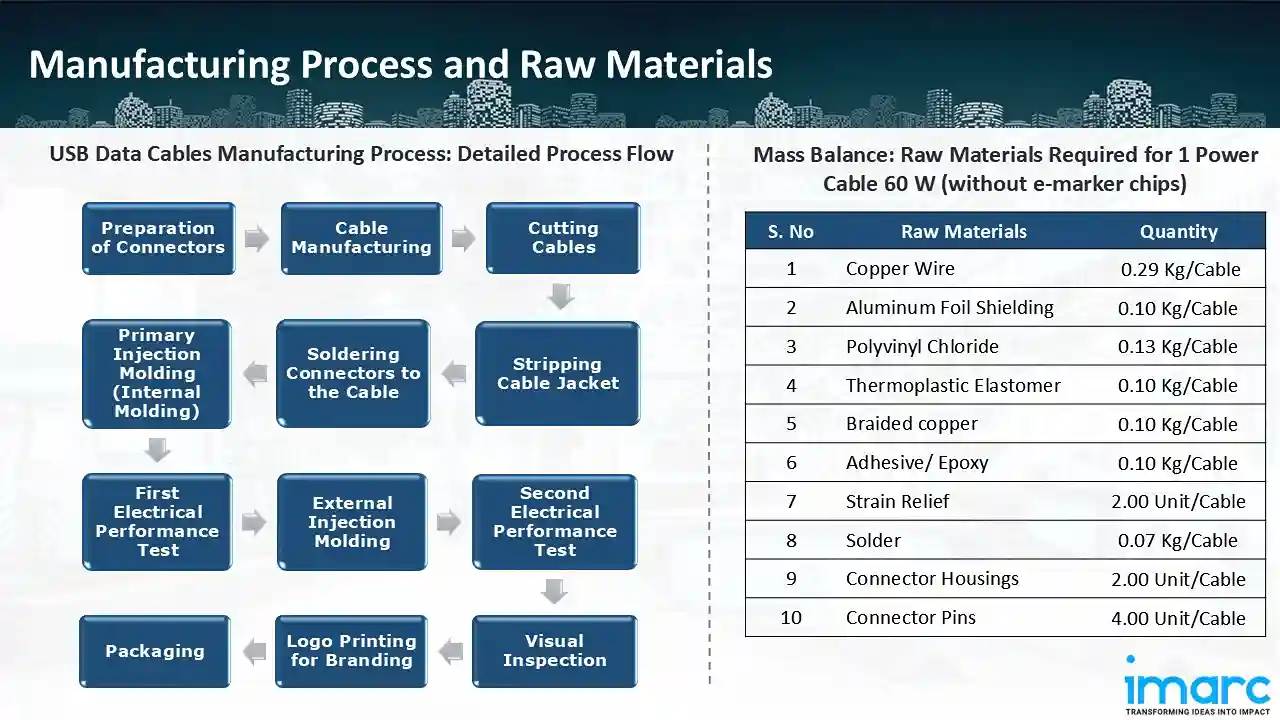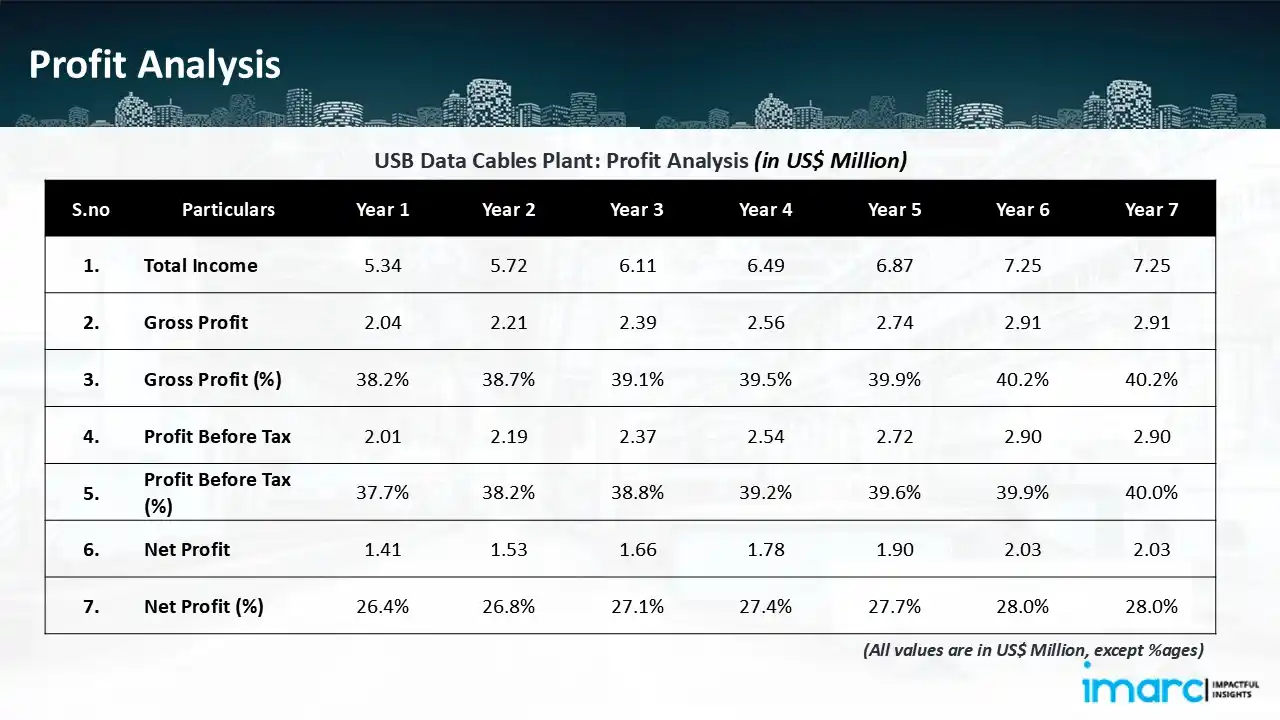Unlocking the Future of Connectivity: The Next Revolution in USB Data Cables-A Comprehensive Cost Model

USB data cables are critical elements of contemporary digital connectivity, enabling high-speed and consistent data transfer and power supply for a broad scope of electronic products. They provide the foundation for charging and synchronizing smartphones, tablets, laptops, and other peripherals, with significant applications in consumer electronics, industrial automation, and new technologies. With technologies like USB-C, the cables today carry faster data speeds, more power output, and universal compatibility, making them essential in a world that is connected. The industry is fueled by increasing smartphone penetration, demand for high-speed data transfer, and ongoing developments in cable strength and design. Furthermore, regulatory compliance and industry associations guarantee improved performance and safety, making them an integral part of daily digital engagement. As per an IMARC report, the world USB data cable market was worth US$ 19.3 Billion in 2024. In the future, the market will advance at a CAGR of around 17.5% during 2025-2033, and it is projected to reach US$ 82.4 Billion by 2033. The worldwide market for USB data cables is motivated by several factors. The increasing adoption of laptops, tablets, and smartphones has notably boosted demand, especially in technologically advanced geographies. Increased dependence on speedy data transfer for work, entertainment, and gaming continues to spur market growth. The shift toward USB-C as a standard with faster charging capabilities and enhanced inter-device connectivity has also driven the industry forward. Cable longevity advances, braided constructions, and intelligent charging features further increase the product's allure. With ongoing innovation in consumer electronics and the drive for non-stop digital connectivity, USB data cables are still critical in fulfilling the changing requirements of the world industries and consumers.
Trending Insights on USB Data Cable: Latest News and Developments
- In February 2025, Nomad introduced its latest ChargeKey, a next-generation compact USB-C cable accessory designed for on-the-go charging and data transfer. The new ChargeKey can be attached to a keychain or kept in an Everyday Carry (EDC) kit, offering compatibility with a range of devices, including iPhone, iPad, MacBook Pro, and Android smartphones. Priced at USD 25, this innovative accessory provides both convenience and functionality for modern users.
- In December 2024, Xiaomi launched two new Mi 6A magnetic self-storage fast-charging data cables in China. Available in USB-C to USB-C and USB-A to USB-C variants, these 1-meter-long cables come in four different colors with a braided finish. The cables also feature magnetic properties, helping users keep them tidy and tangle-free while ensuring fast charging and efficient data transfer.
- In May 2024, Indian brand U&i expanded its product range with the launch of new wireless earbuds and a USB-C data cable. The latest TWS earbuds feature an ergonomic and sweat-resistant build with silicone ear tips for enhanced comfort. The company claims that the earbuds offer an impressive 300-hour standby time, catering to users looking for long-lasting battery life and high-quality sound.
- In January 2023: The Bureau of Indian Standards (BIS) introduced new standards for USB Type-C receptacles, plugs, and cables. These standards aim to establish a common charging solution for smartphones and other electronic devices sold in India. This move is expected to enhance interoperability, reduce e-waste, and improve consumer convenience across various device brands.
- In October 2022: The USB Implementers Forum (USB-IF) published the USB4 Version 2.0 specification, a significant update that enables USB 80Gbps performance over the USB Type-C cable and connector. This development represents a major leap in data transfer speeds, enhancing efficiency, performance, and compatibility across modern electronic devices.
Case Study on Cost Model of USB Data Cable Manufacturing Plant
Objective: One of our clients has approached us to conduct a feasibility study for establishing a mid to large-scale USB data cable manufacturing plant in Morocco. We have developed a detailed financial model for the plant's setup and operations. The proposed facility is designed with a production capacity of 480,000 cables per year, in a proposed land of 1,200 square meters.
Manufacturing Process: The manufacturing process of USB data cables begins with connector preparation, where circuit boards are placed into injection-molded plastic shells, followed by cable manufacturing, where copper or aluminum wires are drawn, annealed, and coated with insulation. The cables are then cut to size using high-speed machines and stripped of their outer jacket to expose the internal conductors. Next, soldering is performed using a semi-automated machine to attach conductors to connectors, followed by primary injection molding for structural reinforcement. A first electrical performance test ensures conductivity before external injection molding applies a final protective PVC layer. The cables undergo a second electrical test for signal integrity and durability, followed by visual inspection for defects. Once approved, logo printing is performed via laser or silk printing. Finally, packaging involves coiling, bundling, and boxing before shipment to retailers and distributors. This streamlined process ensures high-quality, durable USB data cables.
Mass Balance and Raw Material Required: To manufacture 1 power cable 60 W (without e-marker chips), we require 0.29 Kg copper wire, 0.10 Kg aluminum foil shielding, 0.13 Kg polyvinyl chloride, 0.10 Kg thermoplastic elastomer, 0.10 Kg braided copper, 0.10 Kg adhesive/ epoxy, 2.00-unist strain relief, 0.07 Kg solder, 2.00 units connector housings, and 4.00 units connector pins.

Mass Balance and Raw Material Required: To manufacture 1 power cable 240 W (with e-Marker chip), we require 0.29 Kg copper wire, 0.10 Kg aluminum foil shielding, 0.13 Kg polyvinyl chloride, 0.10 Kg thermoplastic elastomer, 0.10 Kg braided copper, 0.10 Kg adhesive/ epoxy, 2.00-unist strain relief, 0.07 Kg solder, 2.00 units connector housings, 4.00 units connector pins, and 1.00-unit e-marker chip.

Mass Balance and Raw Material Required: To manufacture 1 USB4 100 W (with e-Marker chip), we require 0.29 Kg copper wire, 0.10 Kg aluminum foil shielding, 0.13 Kg polyvinyl chloride, 0.10 Kg thermoplastic elastomer, 0.10 Kg braided copper, 0.10 Kg adhesive/ epoxy, 2.00-unist strain relief, 0.07 Kg solder, 2.00 units connector housings, 4.00 units connector pins, and 1.00-unit e-marker chip.

Mass Balance and Raw Material Required: To manufacture 1 Thunderbolt 4 100 W (with e-Marker chip), we require 0.29 Kg copper wire, 0.10 Kg aluminum foil shielding, 0.13 Kg polyvinyl chloride, 0.10 Kg thermoplastic elastomer, 0.10 Kg braided copper, 0.10 Kg adhesive/ epoxy, 2.00-unist strain relief, 0.07 Kg solder, 2.00 units connector housings, 4.00 units connector pins, 1.00-unit e-marker chip, and 1.00-unit capacitor.

List of Machinery:
The following equipment was required for the proposed plant:
- Automatic Feeding Line
- Wire Cut & Strip Machine
- Soldering Machine
- Plastic Injection Machine
- Inner Molding Machine
- Outer Molding
- Testing Machine
- Cable Winding Machine
- Air Compressor
Techno-Commercial Parameter:
- Capital Investment (CapEx): The total capital cost for establishing the proposed USB data cable manufacturing plant is approximately USD 0.45 Million. Civil works cost account for 47.8% of the total capital cost, while machinery costs are estimated at around USD 0.09 Million. The land and site development cost for USB data cable manufacturing plant constitutes a significant portion of the total capital cost, including land registration charges, boundary development cost, and other development charges. This ensures a strong foundation for safe and efficient plant operations.
- Operating Expenditure (OpEx): In a USB data cable manufacturing plant, the operating cost for the first year of operations is projected at USD 3.30 Million. This estimate includes the cost of raw materials, utilities, depreciation, taxes, packing cost, transportation cost, and repairs and maintenance. By the seventh year of operations, the total operational cost is expected to increase by 31.3% compared to the first year, driven by inflation, market fluctuations, and potential rises in the cost of key materials. Disruptions to the supply chain, rising consumer demand, and shifts in the state of the world economy are some of the factors causing this growth.
.webp)
- Profitability Analysis Year on Year Basis: The proposed USB data cable plant, with a capacity of 480,000 USB data cables per year, achieved an impressive revenue of USD 5.34 Million in its first year. We assisted our client in developing a detailed cost model, which projects steady growth, with revenue reaching USD 7.25 Million by year 7. Gross profit margins improve from 38.2% to 40.2%, and net profit margins rise from 26.4% to 28.0%, highlighting strong financial viability and operational efficiency.

Conclusion
Our USB data cable manufacturing plant's financial model was meticulously modelled to satisfy the client's requirements. It provided a thorough analysis of production costs including capital expenditures, manufacturing processes, raw materials, and operating costs. The model predicts profitability while accounting for market trends, inflation, and any shifts in the price of raw materials. It was created especially to satisfy the demand of producing 480,000 of USB data cable per year. Our commitment to offering precise, client-cantered solutions that ensure the long-term success of significant industrial projects by giving the client useful data for strategic decision-making is demonstrated by this comprehensive financial model.
IMARC's Financial Model Expertise: Helping Our Clients Explore Industry Economics
IMARC is a global market research company that offers a wide range of services, including market entry and expansion, market entry and opportunity assessment, competitive intelligence and benchmarking, procurement research, pricing and cost research, regulatory approvals and licensing, factory setup, factory auditing, company incorporation, incubation services, recruitment services, marketing and sales.
Brief List of Our Services: Market Entry and Expansion
- Market Entry and Opportunity Assessment
- Competitive Intelligence and Benchmarking
- Procurement Research
- Pricing and Cost Research
- Sourcing
- Distribution Partner Identification
- Contract Manufacturer Identification
- Regulatory Approvals, and Licensing
- Factory Setup
- Factory Auditing
- Company Incorporation
- Incubation Services
- Recruitment Services
- Marketing and Sales
Under our factory setup services, we assist our clients in exploring the feasibility of their plants by providing comprehensive financial modeling. Additionally, we offer end-to-end consultation for setting up a plant in India or abroad. Our financial modeling includes an analysis of capital expenditure (CapEx) required to establish the manufacturing facility, covering costs such as land acquisition, building infrastructure, purchasing high-tech production equipment, and installation. Furthermore, the layout and design of the factory significantly influence operational efficiency, energy consumption, and labor productivity, all of which impact long-term operational expenditure (OpEx). So, every parameter is covered in the analysis.
At IMARC, we leverage our comprehensive market research expertise to support companies in every aspect of their business journey, from market entry and expansion to operational efficiency and innovation. By integrating our factory setup services with our deep knowledge of industry dynamics, we empower our clients to not only establish manufacturing facilities but also strategically position themselves in highly competitive markets. Our financial modeling and end-to-end consultation services ensure that clients can explore the feasibility of their plant setups while also gaining insights into competitors' strategies, technological advancements, and regulatory landscapes. This holistic approach enables our clients to make informed decisions, optimize their operations, and align with sustainable practices, ultimately driving long-term success and growth.
Contact Us
Have a question or need assistance? Please complete the form with your inquiry or reach out by emailing us on sales@imarcgroup.com.

